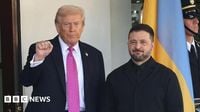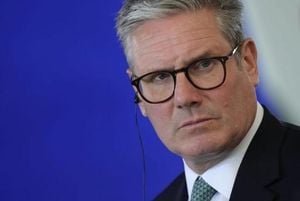On October 17, 2025, a fresh twist emerged in the ongoing Russia-Ukraine war as Ukrainian President Volodymyr Zelenskyy made a bold proposal at the White House: Ukraine would trade its homegrown military drones for the United States’ Tomahawk cruise missiles. The suggestion, made during a high-profile meeting with U.S. President Donald Trump, underscored the shifting dynamics of military technology and diplomatic leverage in a conflict that has stretched on for more than three years.
Ukraine’s prowess in drone warfare has become a defining feature of its resistance against Russian aggression. According to the BBC, the country is now recognized as the world leader in military drones, a reputation forged in the crucible of relentless conflict. With thousands of drones at its disposal, Ukraine has relied on these agile machines to counter Russian advances and conduct surveillance. Yet, as Zelenskyy pointed out in Washington, what Ukraine lacks are the kind of long-range, high-impact missiles that could alter the calculus on the battlefield—specifically, the U.S.-made Tomahawks.
“We build our own drones, but we also buy drones from others, and they make a very good drone,” President Trump acknowledged during the meeting, as reported by BBC and other outlets. He went on to highlight how drone warfare has "really come to the fore" in recent years, a direct result of the Russia-Ukraine war’s technological arms race. The U.S. president’s response to Zelenskyy’s proposal was notably positive. When asked if the United States was interested in such a deal, Trump replied simply, “We are.”
The timing of Zelenskyy’s offer was no accident. Just a day earlier, Trump had suggested he might not be willing to sell Tomahawk missile systems to Ukraine. His hesitation reportedly followed a phone call with Russian President Vladimir Putin, after which Trump announced plans to meet Putin in Budapest, Hungary. The details of that upcoming meeting remain murky, with Trump telling reporters that Zelenskyy’s participation was “to be determined.” Still, Trump hinted at the possibility of a “double meeting,” suggesting that Ukraine would remain closely involved in the process, if not at the table itself.
“These two leaders do not like each other and we want to make it comfortable for everybody,” Trump remarked, referencing the frosty relationship between Putin and Zelenskyy. He added that there is “bad blood” between the two, a reality that has complicated every step of diplomatic negotiation since the war’s outbreak.
For Zelenskyy, the meeting was not just about hardware; it was about momentum. He publicly congratulated Trump on his efforts to broker a truce between Israel and Hamas, telling the U.S. president, “President Trump now has a big chance to finish this war.” The Ukrainian leader’s words reflected a widespread hope in Kyiv that the White House could leverage its influence to bring about a breakthrough in negotiations with Moscow.
Yet, even as diplomacy played out in Washington and Budapest, the situation on the ground in Ukraine remained dire. The BBC’s chief North America correspondent, reporting from Kyiv, described a country still under daily attack. Infrastructure, especially the Ukrainian railway system, has become a frequent target for Russian strikes. Earlier in October, around 30 people were injured when a Russian drone hit a train in Shostka, a grim reminder of the war’s toll on civilians and critical logistics.
“We’ve seen a sharp increase in shelling,” Ukraine’s Deputy Prime Minister for Recovery, Oleksiy Kuleba, told the BBC. “The shelling used to be once or twice a week but today we’ve seen it happen dozens of times a day.” Kuleba explained that Russia’s strategy is to “cut our logistics and destroy our infrastructure,” endangering both passengers and railway workers. The attacks are not just about military targets—they’re aimed at crippling Ukraine’s ability to function, to move people and supplies, and to maintain any semblance of normal life.
Against this backdrop, the question of whether U.S. Tomahawk missiles could change the course of the conflict looms large. The BBC and other outlets have explored the potential impact of such weapons. Tomahawks, with their long range and precision, could enable Ukraine to strike deep into Russian-held territory, potentially shifting the balance of power. Yet, as Trump himself noted in a press Q&A, the United States “needs Tomahawks” for its own defense, and he hopes to end the war before the need arises to send them to Ukraine.
Trump’s caution reflects broader uncertainties within the U.S. administration and among America’s allies. The prospect of arming Ukraine with Tomahawks is fraught with geopolitical risk, particularly given Russia’s warnings about escalation. At the same time, the idea of a drone-for-missile trade offers a novel workaround—one that could strengthen both countries’ arsenals while sidestepping some of the diplomatic pitfalls of a straightforward arms transfer.
As negotiations continue, the fate of Zelenskyy’s proposal remains uncertain. Trump’s openness to the idea marks a departure from his previous reluctance, but much depends on the outcome of his meeting with Putin in Budapest. According to Trump, the mere possibility of the U.S. arming Ukraine with Tomahawks may have been enough to bring Putin to the negotiating table. “I think he wants to make a deal. That’s all. I can’t tell you what’s bringing them. Sure … the threat of that is good, but the threat of that is always there,” Trump said.
For Ukrainians, the stakes could hardly be higher. The war has already lasted more than three years, with no clear end in sight. Daily attacks on infrastructure, mounting casualties, and the constant threat of escalation have left the country weary but determined. The prospect of acquiring Tomahawk missiles—whether through a trade or direct supply—offers a glimmer of hope that Ukraine might finally gain the upper hand, or at least force Russia back to the negotiating table in earnest.
Yet, as with so many moments in this conflict, optimism is tempered by hard reality. The proposed deal, while innovative, is entangled in the broader web of U.S.-Russia relations, shifting political winds in Washington, and the unpredictable calculations of all three leaders. For now, the world watches and waits, as the fate of Ukraine—and perhaps the wider balance of power in Europe—hangs in the balance.
As the diplomatic chess game continues, the outcome of this high-stakes proposal could set a precedent for military cooperation and negotiation in conflicts far beyond Ukraine’s borders.






